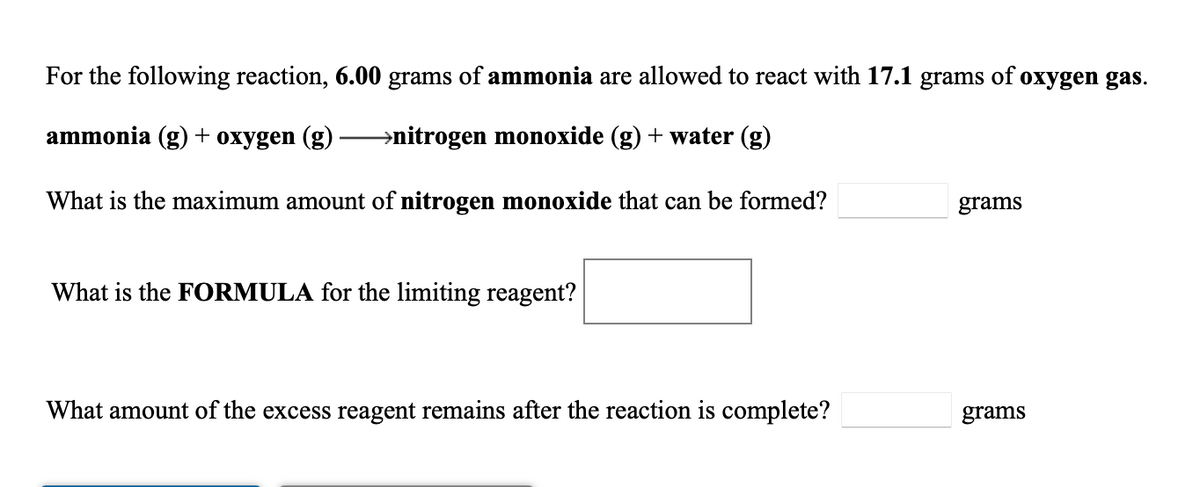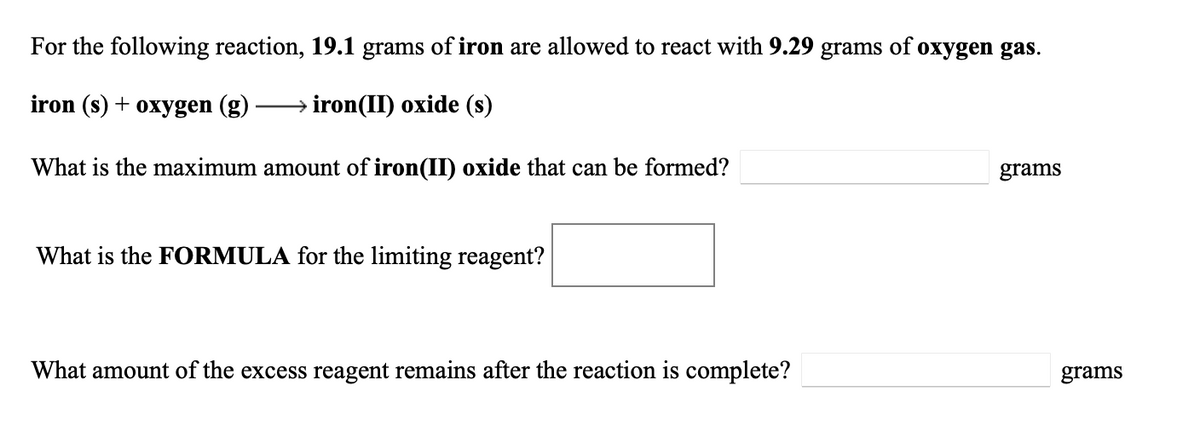For the following reaction, 6.00 grams of ammonia are allowed to react with 17.1 grams of oxygen gas. ammonia (g)+ oxygen (g) →nitrogen monoxide (g) + water (g) What is the maximum amount of nitrogen monoxide that can be formed? grams What is the FORMULA for the limiting reagent? What amount of the excess reagent remains after the reaction is complete? grams
For the following reaction, 6.00 grams of ammonia are allowed to react with 17.1 grams of oxygen gas. ammonia (g)+ oxygen (g) →nitrogen monoxide (g) + water (g) What is the maximum amount of nitrogen monoxide that can be formed? grams What is the FORMULA for the limiting reagent? What amount of the excess reagent remains after the reaction is complete? grams
Chemistry & Chemical Reactivity
9th Edition
ISBN:9781133949640
Author:John C. Kotz, Paul M. Treichel, John Townsend, David Treichel
Publisher:John C. Kotz, Paul M. Treichel, John Townsend, David Treichel
Chapter4: Stoichiometry: Quantitative Information About Chemical Reactions
Section: Chapter Questions
Problem 15PS: The reaction of methane and water is one way to prepare hydrogen for use as a fuel: CH4(g) + H2O(g) ...
Related questions
Question

Transcribed Image Text:For the following reaction, 6.00 grams of ammonia are allowed to react with 17.1 grams of oxygen gas.
ammonia (g) + oxygen (g)
→nitrogen monoxide (g) + water (g)
What is the maximum amount of nitrogen monoxide that can be formed?
grams
What is the FORMULA for the limiting reagent?
What amount of the excess reagent remains after the reaction is complete?
grams

Transcribed Image Text:For the following reaction, 19.1 grams of iron are allowed to react with 9.29
grams
of
oxygen gas.
iron (s) + oxygen (g)
iron(II) oxide (s)
What is the maximum amount of iron(II) oxide that can be formed?
grams
What is the FORMULA for the limiting reagent?
What amount of the excess reagent remains after the reaction is complete?
grams
Expert Solution
This question has been solved!
Explore an expertly crafted, step-by-step solution for a thorough understanding of key concepts.
This is a popular solution!
Trending now
This is a popular solution!
Step by step
Solved in 4 steps

Knowledge Booster
Learn more about
Need a deep-dive on the concept behind this application? Look no further. Learn more about this topic, chemistry and related others by exploring similar questions and additional content below.Recommended textbooks for you

Chemistry & Chemical Reactivity
Chemistry
ISBN:
9781133949640
Author:
John C. Kotz, Paul M. Treichel, John Townsend, David Treichel
Publisher:
Cengage Learning

Chemistry & Chemical Reactivity
Chemistry
ISBN:
9781337399074
Author:
John C. Kotz, Paul M. Treichel, John Townsend, David Treichel
Publisher:
Cengage Learning

Chemistry: The Molecular Science
Chemistry
ISBN:
9781285199047
Author:
John W. Moore, Conrad L. Stanitski
Publisher:
Cengage Learning

Chemistry & Chemical Reactivity
Chemistry
ISBN:
9781133949640
Author:
John C. Kotz, Paul M. Treichel, John Townsend, David Treichel
Publisher:
Cengage Learning

Chemistry & Chemical Reactivity
Chemistry
ISBN:
9781337399074
Author:
John C. Kotz, Paul M. Treichel, John Townsend, David Treichel
Publisher:
Cengage Learning

Chemistry: The Molecular Science
Chemistry
ISBN:
9781285199047
Author:
John W. Moore, Conrad L. Stanitski
Publisher:
Cengage Learning

General Chemistry - Standalone book (MindTap Cour…
Chemistry
ISBN:
9781305580343
Author:
Steven D. Gammon, Ebbing, Darrell Ebbing, Steven D., Darrell; Gammon, Darrell Ebbing; Steven D. Gammon, Darrell D.; Gammon, Ebbing; Steven D. Gammon; Darrell
Publisher:
Cengage Learning

World of Chemistry, 3rd edition
Chemistry
ISBN:
9781133109655
Author:
Steven S. Zumdahl, Susan L. Zumdahl, Donald J. DeCoste
Publisher:
Brooks / Cole / Cengage Learning

General, Organic, and Biological Chemistry
Chemistry
ISBN:
9781285853918
Author:
H. Stephen Stoker
Publisher:
Cengage Learning